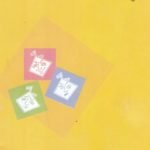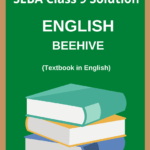Class 9 English Chapter 6 My Childhood, NCERT/SCERT Class 9 English Beehive Question Answer to each chapter is provided in the list of SEBA ইংৰাজী Class 9 Question Answer so that you can easily browse through different chapters and select needs one. Class 9 English Beehive Prose Chapter 6 My Childhood Question Answer can be of great value to excel in the examination.
Class 9 English Chapter 6 My Childhood
SEBA Class 9 English Chapter 6 My Childhood Notes covers all the exercise questions in Assam Board SEBA Textbooks. The SEBA Class 9 English Beehive Chapter 6 My Childhood provided here ensures a smooth and easy understanding of all the concepts. Understand the concepts behind every chapter and score well in the board exams.
My Childhood
Chapter – 6
BEEHIVE (PROSE)
TEXTUAL QUESTIONS AND ANSWERS
Thinking about the text:
Activity:
Q. What language(s) do you think are spoken in Rameswaram and Dhanuskodi? What languages do you think the author, his family, his friends and his teachers spoke with one another?
Ans. Rameswaram and Dhanuskodi are situated in the former state of Madras, now renamed Tamilnadu. Naturally it is expected that the people in those areas spoke Tamil.
The author was born in a Tamil family. Naturally he and the members of his family spoke Tamil. So also his friends and teachers spoke Tamil. How-ever, it is possible that his teachers spoke English whenever it was needed to.
I. Answer these questions in one or two sentences each:
Q.1. Where was Abdul Kalam’s house?
Ans. Abdul Kalam’s house was situated on the Mosque street in Rameswaram.
Q.2. What do you think Dinamoni is the name of? Give reasons for your answer.
And. Dinamani is the name of a local newspaper. It is so because Kalam traced the stories of the war in the head lives in Dinamani.
Q.3. Who were Abdul Kalam’s school friends? What did they later become?
Ans. Abdul Kalam’s school friends were:- Ramanadha sastry, Aravindan, and sivaprakasam.
Ramanadha Sastry took over the priesthood of Rameswaram temple, Aravinden went for arranging transport for visiting pilgrims and Sivaprakasan became a catering contractor for the southern Railways.
Q.4. How did Abdul Kalam earn his first wages?
Ans. Abdul helped his cousin Samsuddin in the work of the newspaper and gave him wages. Thus he earned his first wage.
Q.5. Had he earned any money before that? In what way?
Ans. Yes, he earned money by collecting tamarind seeds and selling them to a provision shop on Mosque Street.
II. Answer each of these questions in a short paragraph (about 30 words)
Q.1. How does the author describe:
(i) his father.
Ans. Abdul Kalam’s father was a man of meagre means but strict disciplinarian. He used to avoid all inessential comforts but provided all the necessities for living.
(ii) his mother.
Ans. His mother was an embodiment of goodness and kindness. She used to tell about events from the Ramayana and from the life of the prophet at bedtime.
(iii) himself.
Ans. Abdul himself was a genius scientist. His projects in space, defence and nuclear technology were guiding India to make him leap in the 21st Century.
Q.2. What characteristics does he say he inherited from his parents?
Ans. Abdul Kalam inherited honesty and self discipline from his father. He inherited faith in goodness and deep kindness from his mother.
III. Discuss these questions in class with your teacher and write down your answer in two or three paragraphs each.
1. “On the whole, the small society of Rameswaram was very rigid in terms of the segregation of different social groups.” says the author.
(i) Which social groups does he mention? Were these groups easily identifiable (for example by the way they dressed)?
Ans: There were several different groups in Rameswaram. Most of these belonged to orthodox Brahmin Families. These groups were easily identifiable. Muslims wore caps on their heads while the Hindu had sacred thread in their body. Brahmin ladies were much orthodox in their views and often felt ill for entering their kitchens. They did not even want to serve food.
(ii) Were they aware of their differences or did they also naturally share friendships and experiences? (Think of the bedtime stories in Kalam’s house; of who his friends were; and what used to take place in. the pond near his house.)
Ans: Though they were aware of the castes yet they shared their natural friendships and experiences. The mother of the Kalam used to tell him events from the Ramayana and the life of the prophet. Even the parents too hated the poison of communalism.
During the annual shri Sita Rama Kalyanam ceremony, Kalam’s family used to arrange boats with a special platform for carrying the idol of lord from the temple to the marriage site. The site was situated in the middle of the pond called Rama Tirtha which was quite near to Kalam’s house.
(iii) The author speaks both of people who were very much aware of the differences among them and those who tried to bridge the difference. Can you identify such people in the text?
Ans: Once a new teacher came to their class he Could not bear Kalam’s sitting with a Hindu boy. He made Kalam sit on the last bench. After school the boys told the incident to their parents. Kalam’s friend, Ramanadha Sastry immediately called the teacher and told him not to spread communal intolerance in the innocent minds. The new teacher apologised and reformed himself.
(iv) Narrate two incidents that show how differences can be created and how they can be resolved. How can people change their attitude?
Ans: The first incident was when a new teacher came to their class he Could not bear Kalam’s sitting with a Hindu boy. He made Kalam sit on the last bench. After school the boys told the incident to their parents. Kalam’s friend, Ramanadha Sastry immediately called the teacher and told him not to spread communal intolerance in the innocent minds. The new teacher apologised and reformed himself.
The second incident was when the science teacher invited Kalam for dinner at his home. His wife was very conservative. But he was a rebel and the science teacher didn’t believe in caste and creed. His wife refused to serve a muslim boy in her kitchen. He himself served Abdul and sat down by his side to eat his meal. When Abdul was leaving he invited him for dinner again the next weekend. When Abdul visited his house next week, his wife took him inside her kitchen and served him food with her own hands.
2. (i) Why did Abdul Kalam want to leave Rameswarm?
Ans: Abdul Kalam wanted to leave Rameswaram to study at the district headquarters in Ramanathapuram.
(ii) What did his father say to him?
Ans: His father knew that Abdul would have to go away to grow. So he gave permission. He said Abdul “Does the seagull not fly across the sun, alone and without a nest.”
(iii) What do you think his words mean? Why do you think he spoke these words?
Ans: His words meant he understood that Kalam had to leave his house and get a good higher education to grow. He spoke these words because he knew the harsh reality of life that the children need to move away from their home and parents to make a career and earn.

Hi, I’m Dev Kirtonia, Founder & CEO of Dev Library. A website that provides all SCERT, NCERT 3 to 12, and BA, B.com, B.Sc, and Computer Science with Post Graduate Notes & Suggestions, Novel, eBooks, Biography, Quotes, Study Materials, and more.








Hi